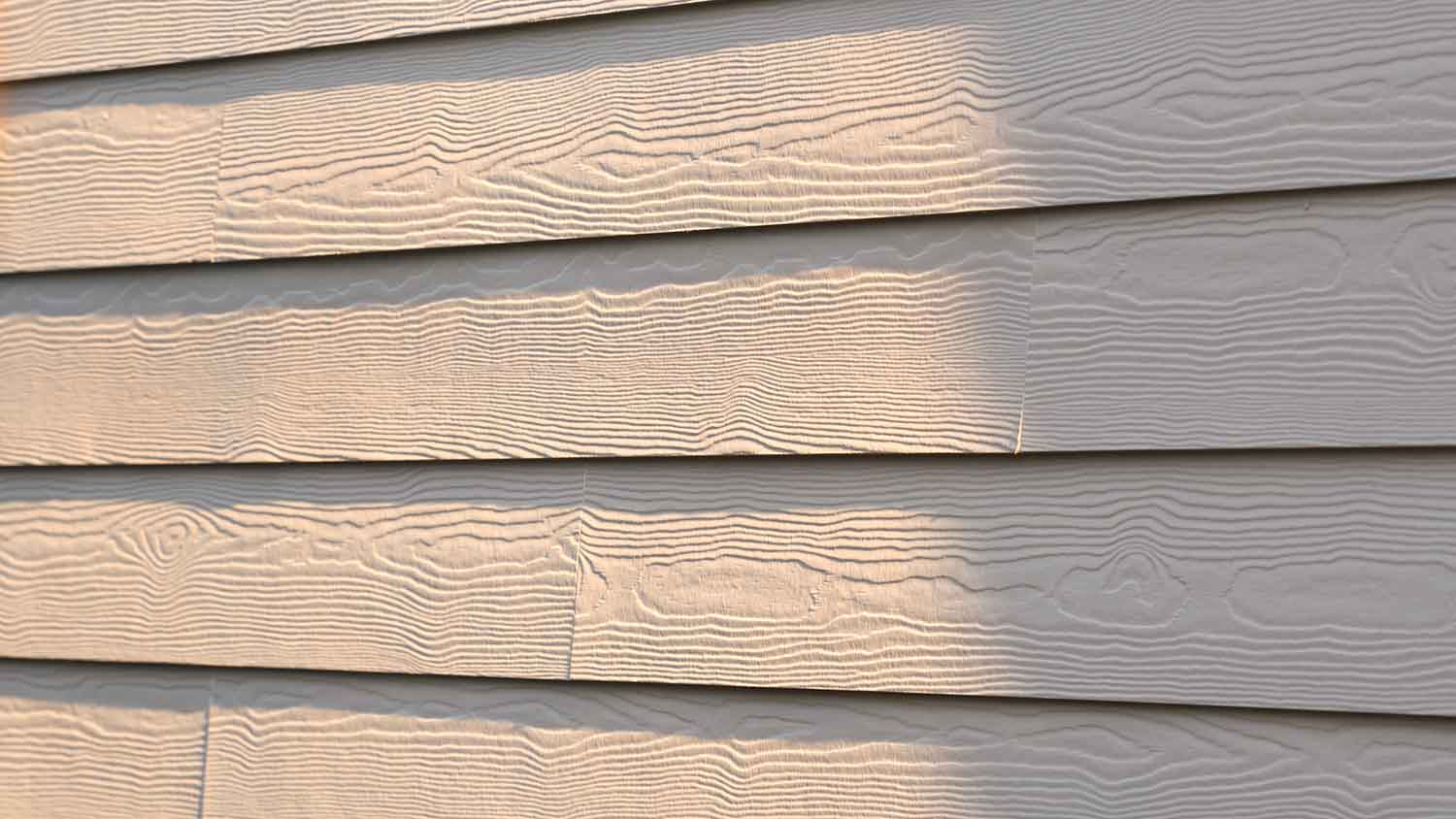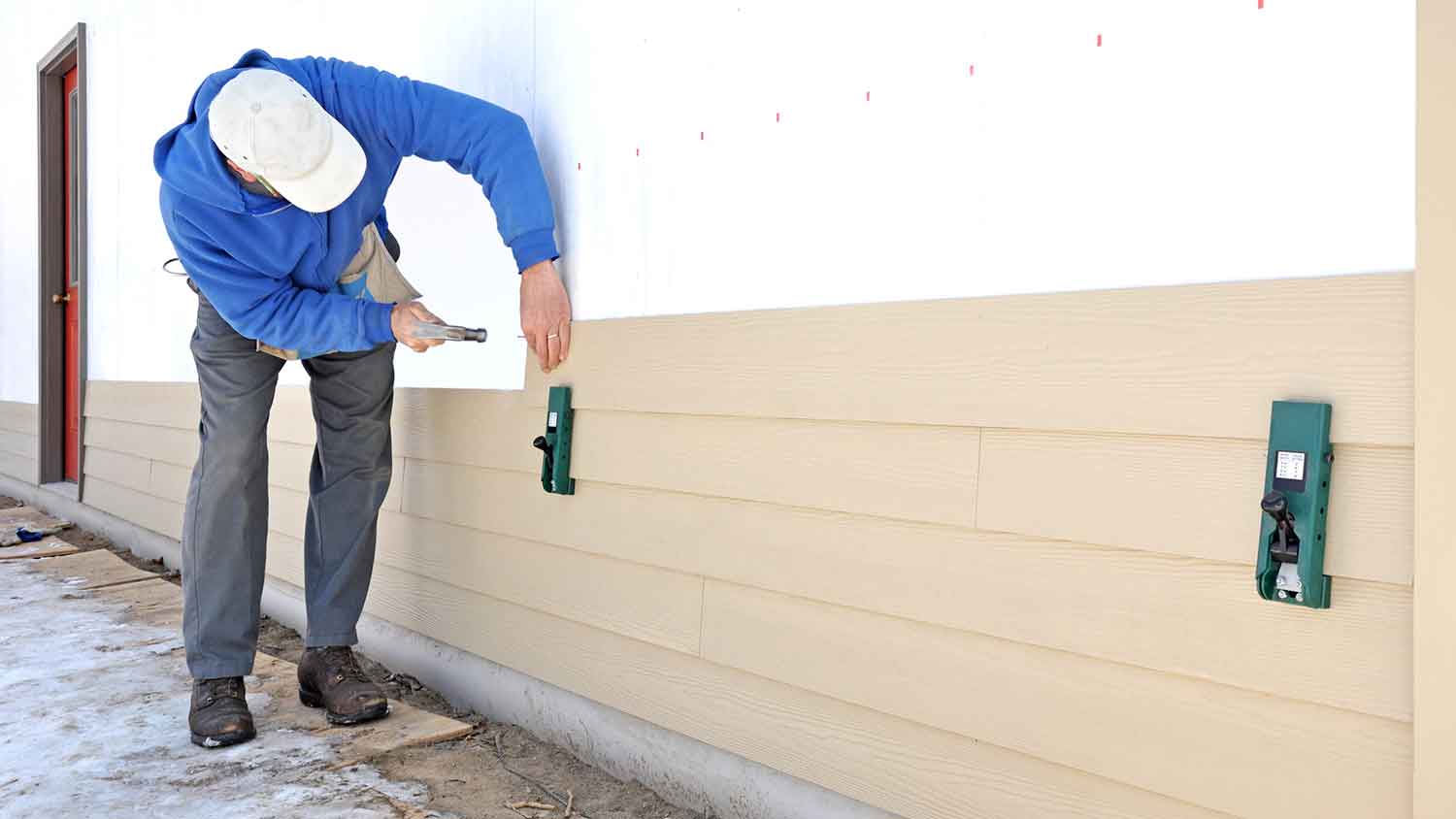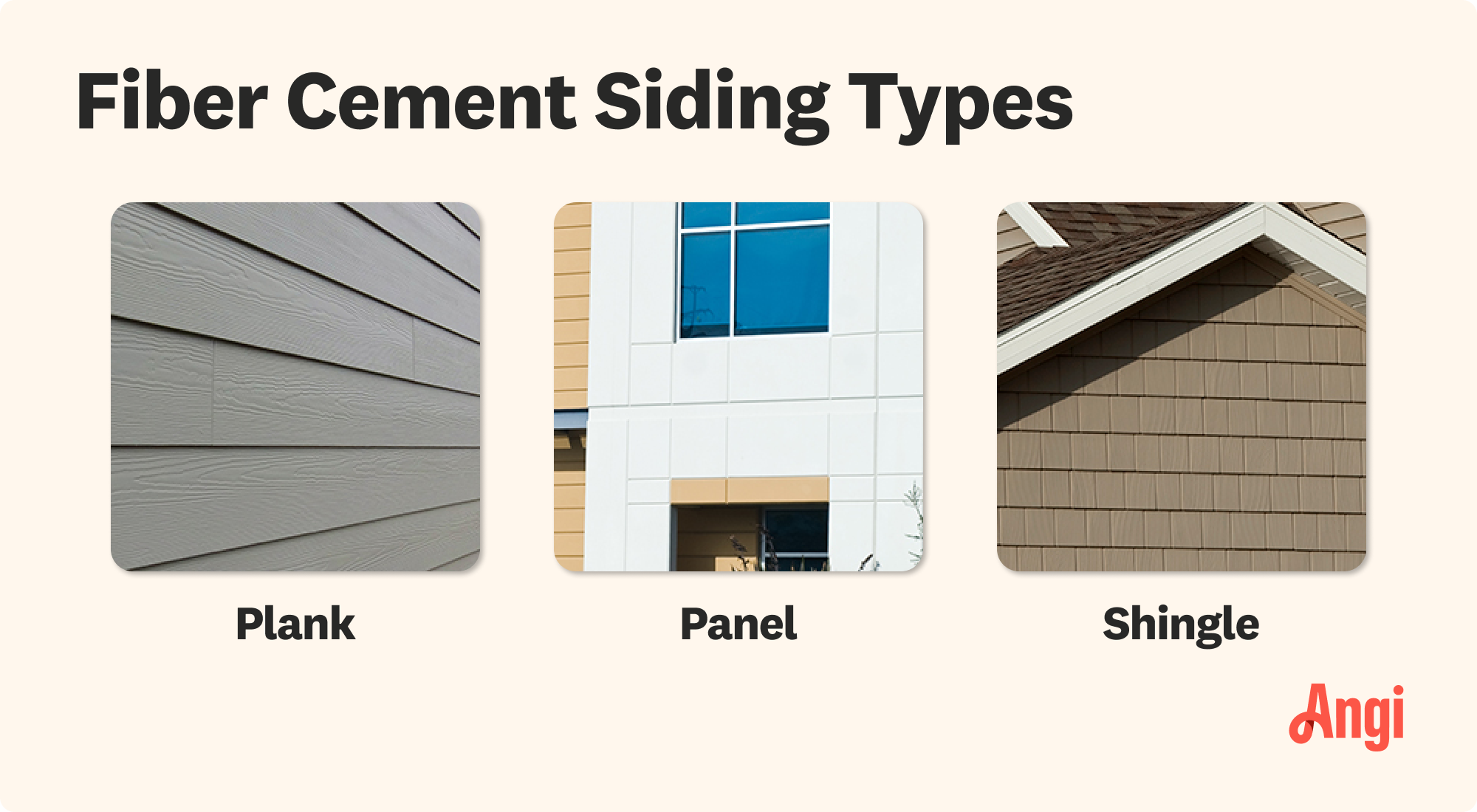
New vinyl siding can freshen up your home while protecting against water damage. Learn about average vinyl siding installation costs in Los Angeles.
Fiber cement siding is extremely durable, but it comes at a cost


The benefits of fiber cement siding include its longevity, durability, and resistance to pests.
Drawbacks of fiber cement material include cost, environmental impact, and maintenance.
Fiber cement siding can mimic nearly all types of siding, making it more versatile than other siding types.
The cost of fiber cement siding is $5 to $14 per square foot.
Fiber cement siding has a lot to offer your home’s exterior, mainly that it’s long-lasting and durable. Before you nail down your final decision, let’s take a look at the pros and cons of fiber cement siding and measure how it stacks up against other alternatives.
If you’ve looked up information about fiber cement siding, you’ve no doubt come across Hardie Board, which is a major manufacturer of this material by James Hardie™. Fiber cement siding was introduced in the mid-1980s as a replacement for siding containing asbestos, which was discontinued in 1989 due to safety concerns.
While Hardie Board was the first, it’s certainly not the last. Several other manufacturers now make fiber cement siding from a mixture of cellulose fibers, sand, and cement, but every manufacturer has their own composition. Consult a local siding contractor to determine whether fiber cement is the right siding material for your home.
| Pros of Fiber Cement Siding | Cons of Fiber Cement Siding |
|---|---|
| Lasts up to 50 years | Higher cost range |
| Durable against extreme weather | Not recyclable |
| Fire and heat-resistant | Heavy and difficult to install |
| Animal- and pest-resistant | Regular painting is required |
| Highly versatile |

Check out the benefits of installing fiber cement siding on your home’s exterior.
Fiber cement siding is extremely durable and holds up well against the elements. It can last up to 50 years if you keep up with maintenance, and some manufacturers' warranties can be about that long.
Durability is often the main appeal of this material. Fiber cement siding is so strong that it can withstand hurricane-strength winds and other extreme weather conditions like hail. It will not dent, warp, or rot.
Fiber cement is resistant to fire and heat, making it a smart choice if you live in an area with wildfires. It has a 0 flame spread rating, and because it’s listed as a Class 1 material, it doesn’t actively fuel a fire.
Pests like termites and beetles can’t chew or drill through fiber cement siding. It’s also safe from small animals and birds. Fiber cement siding doesn’t expand and contract either, so it doesn’t invite nesting insects.
One of the benefits of fiber cement siding is that it can mimic the look of nearly all types of siding, and most manufacturers also carry traditionally colored architectural siding to meet historical society specifications. It can be installed vertically, horizontally, or as trim and comes in various shapes, thicknesses, and textures.

Check out the problems with installing fiber cement siding on your home’s exterior.
Costing between $5 and $14 per square foot, fiber cement siding is more expensive than most other siding types. The price of fiber cement siding will depend on the manufacturer (Hardie Board is more expensive than other manufacturers), and the type—shingles are the cheapest, followed by planks and panels. Its installation may also cost more. You’ll want to reach out to a local fiber cement siding company for a more accurate estimate.
Fiber cement siding is not recyclable, which means it’s not eco-friendly. However, once installed, it’s inert and non-toxic. And because it lasts for decades, it has a low carbon footprint.
Fiber cement siding installation can be difficult. It’s heavy—50 square feet weighs about 150 pounds, and its rigidity makes it easily breakable. Cutting fiber cement releases crystalline silica, which is hazardous when inhaled.
Once fiber cement siding is installed, you’ll need to clean and paint it every decade to keep it looking fresh. While the material itself is moisture resistant, proper installation and regular maintenance are important to keep mold at bay.

Fiber cement's ability to imitate other popular siding options is one of its greatest perks. The material gives homeowners the chance to add the look of brick, stone, or wood veneer without the high price tag or maintenance issues that come with the real thing. Here are some of the most popular types of fiber cement siding.
Some of the top brands of fiber cement siding, such as James Hardie, offer panels of shingles that mimic wood and vinyl siding shingles in a full range of paintable colors.
Wood lap, or clapboard, imitates the most classic style of home siding. Long planks line up horizontally and give the appearance of classic painted wood.
Fiber cement comes in panels that imitate stucco, offering a highly durable option for modern homes and commercial buildings. While they are still complicated to install, fiber cement requires less maintenance and repairs over the years than stucco siding.
Homeowners can get that rustic charm with fiber cement by chiseling it to look like brick or stone siding. Choose from a range of brick colors and styles as well as a stone design that imitates a masonry wall.
If you’ve weighed the pros and cons of fiber cement siding and are still not convinced it’s for you, there are several other siding varieties to choose from. These are some of the most popular options.
Vinyl siding comes in many colors, textures, and styles. It’s low cost, at about $3 to $12 per square foot. It lasts up to 40 years and only needs to be cleaned with water from a garden hose.
Wood siding costs about $1 to $15 per square foot, depending on the type, and is also available in many finishes, styles, and textures. It does require paint or a stain, and it’s not impervious to moisture, pests, or weather extremes.
Aluminum siding costs about $3 to $6 per square foot, and steel costs $4 to $16 per square foot. Metal siding compared to fiber cement is low maintenance but is prone to denting. It’s available in a wide range of styles, including shingles, panels, vertical strips, and shingles.
Brick masonry and brick veneer siding both offer a classic home style with a material trusted for centuries. You'll pay anywhere between $5 and $20 per square foot for either option, though building brick masonry walls is more common during initial construction.
Similar to brick, stone siding comes either as a stone veneer or, less commonly, as a stone masonry wall. Choose between natural and manufactured stone, including fiber cement. However, you can pay up to $42 per square foot for the most sought-after stone siding materials.
EIFS siding, or Exterior Insulation and Finish Systems, has been a popular alternative to stucco since the 1970s. Its multilayered system offers durability, strong insulation, and a lighter-weight option compared to stucco.
Fiber cement siding is a great option for homeowners looking for a durable, long-lasting siding solution. Whether it’s right for your home mostly depends on your budget and your desired exterior aesthetics.
Fiber cement siding may not be the best choice if you prefer to DIY—the weight and complex installation process means this is a job best left to the pros. Hire a siding contractor who specializes in fiber cement to ensure it’s installed correctly to protect your home for decades to come. Improperly installed siding can lead to water damage, mold growth, and serious damage to your home’s exterior.
This was our first cross-country move, and we were at our wits’ end. Thankfully, Goodview Moving and Storage experts were patient, explained the schedule, gave us updates along the way, and delivered everything right on time. Kudos to them!
Made our old outdated apartment come alive again. Fresh paint, fixed any bumps or cracks in walls and ceilings, worked fast and did excellent work! Would definitely hire again. Easy to contact and did what I asked- happy customer Here!
Bayside Home Improvement did an incredible job remodeling our home! They helped us reimagine the layout, update the finishes, and create a space that better suits our lifestyle. Their attention to detail and commitment to quality craftsmanship were evident throughout the entire project....
GMJ is the perfect spot if you are after an outstanding Eichler home. Joseph communication skills are top-notch, and he understood my needs perfectly. They have incredibly creative and brilliant minds and really grasp what the customer desires. Thanks a bunch, Joseph, for all your assistance!...
Had these guys add 850 SQFT to my home. I could not recommend them enough. Process went faster than expected and they helped out dealing with permitting in Miami which was a plus. I highly recommend them and I did not have any issues
Hiring SJZ for our ADU project was the best decision. Sammy created a brilliant design that maximized the allowable space, and his crew brought it to life beautifully. The final unit is a stunning, functional living space that is been a game-changer for our property. Could not recommend SJZ...
Very good communication, and they are able to get the job done in a timely fashion. Definitely recommend them if you need any help with moving.
HolmeStage are the best stagers I ever worked with. Great communication, answer phone calls and texts. Very responsive. And they love what they do! They have great taste and will make your listings very presentable.
My experience with this company was wonderful. I worked with Brittany. She was very patient and informative. She took me through the process, step by step. When I had questions or concerns, either her or the manager Betty spent a lot of time talking with me and explaining the process to me....
Another Angie's List provider suggested that I contact Midland Exteriors when they realized that it would not be possible to perform the tasks. I then called Midland Exteriors who sent an estimator over right away. We discussed the problems and he said that within 24 hours I would receive an...
From average costs to expert advice, get all the answers you need to get your job done.

New vinyl siding can freshen up your home while protecting against water damage. Learn about average vinyl siding installation costs in Los Angeles.

Siding repairs can boost your home’s value and efficiency. Use this guide to learn how much siding repair costs in Los Angeles based on factors like your home’s size.

New siding improves curb appeal, increases home value, and insulates your home. Learn about fiber cement siding installation costs in Los Angeles.

Regularly cleaning vinyl siding helps your house look better and last longer. Find out how you can tackle this DIY project on your own.

How much does clapboard siding cost? This guide reviews cost factors, prices per square foot, and more to help you plan your budget.

Exterior Insulation and Finish Systems, or EIFS, is a stucco look-a-like but is actually very different. It can be hard to clean and expensive to install, but EIFS is a durable, energy-efficient, and attractive option to spruce up any home.